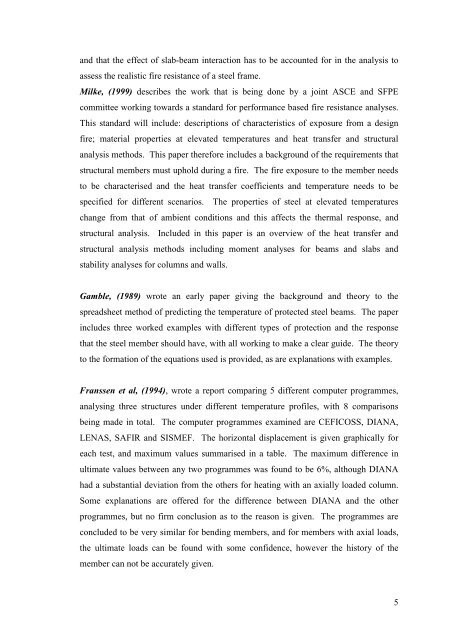FIRE DESIGN OF STEEL MEMBERS - Civil and Natural Resources ...
FIRE DESIGN OF STEEL MEMBERS - Civil and Natural Resources ...
FIRE DESIGN OF STEEL MEMBERS - Civil and Natural Resources ...
Create successful ePaper yourself
Turn your PDF publications into a flip-book with our unique Google optimized e-Paper software.
<strong>and</strong> that the effect of slab-beam interaction has to be accounted for in the analysis to<br />
assess the realistic fire resistance of a steel frame.<br />
Milke, (1999) describes the work that is being done by a joint ASCE <strong>and</strong> SFPE<br />
committee working towards a st<strong>and</strong>ard for performance based fire resistance analyses.<br />
This st<strong>and</strong>ard will include: descriptions of characteristics of exposure from a design<br />
fire; material properties at elevated temperatures <strong>and</strong> heat transfer <strong>and</strong> structural<br />
analysis methods. This paper therefore includes a background of the requirements that<br />
structural members must uphold during a fire. The fire exposure to the member needs<br />
to be characterised <strong>and</strong> the heat transfer coefficients <strong>and</strong> temperature needs to be<br />
specified for different scenarios. The properties of steel at elevated temperatures<br />
change from that of ambient conditions <strong>and</strong> this affects the thermal response, <strong>and</strong><br />
structural analysis. Included in this paper is an overview of the heat transfer <strong>and</strong><br />
structural analysis methods including moment analyses for beams <strong>and</strong> slabs <strong>and</strong><br />
stability analyses for columns <strong>and</strong> walls.<br />
Gamble, (1989) wrote an early paper giving the background <strong>and</strong> theory to the<br />
spreadsheet method of predicting the temperature of protected steel beams. The paper<br />
includes three worked examples with different types of protection <strong>and</strong> the response<br />
that the steel member should have, with all working to make a clear guide. The theory<br />
to the formation of the equations used is provided, as are explanations with examples.<br />
Franssen et al, (1994), wrote a report comparing 5 different computer programmes,<br />
analysing three structures under different temperature profiles, with 8 comparisons<br />
being made in total. The computer programmes examined are CEFICOSS, DIANA,<br />
LENAS, SAFIR <strong>and</strong> SISMEF. The horizontal displacement is given graphically for<br />
each test, <strong>and</strong> maximum values summarised in a table. The maximum difference in<br />
ultimate values between any two programmes was found to be 6%, although DIANA<br />
had a substantial deviation from the others for heating with an axially loaded column.<br />
Some explanations are offered for the difference between DIANA <strong>and</strong> the other<br />
programmes, but no firm conclusion as to the reason is given. The programmes are<br />
concluded to be very similar for bending members, <strong>and</strong> for members with axial loads,<br />
the ultimate loads can be found with some confidence, however the history of the<br />
member can not be accurately given.<br />
5
















